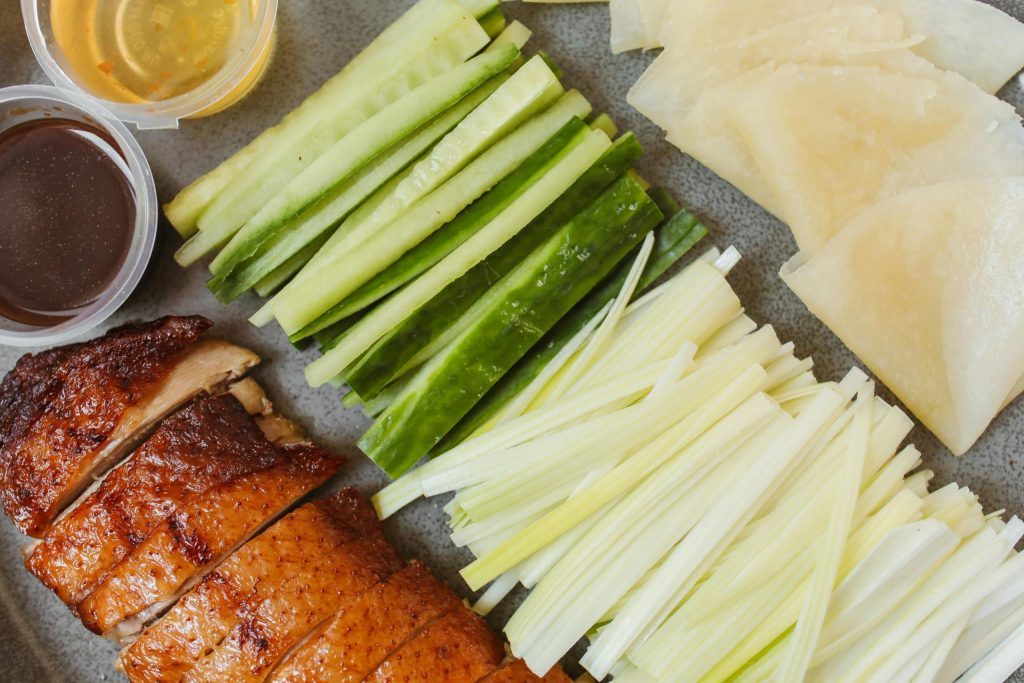Introduction: A Culinary Journey Through Beijing’s Rich Food Heritage
Beijing’s culinary landscape offers Western travelers an extraordinary gateway into 3,000 years of Chinese imperial history and street food culture. As China’s capital, Beijing cuisine (京菜) blends northern Chinese traditions with imperial court influences, creating dishes that are both hearty and refined. From the world-famous Peking duck to lesser-known street food gems, Beijing’s food scene promises cultural discoveries that will challenge your preconceptions about Chinese cuisine.
For first-time Western visitors, Beijing’s food culture might seem intimidating, but rest assured that the city maintains high food safety standards, especially in established restaurants and popular food districts. Most ingredients are fresh, locally sourced, and prepared with centuries-old techniques that prioritize both flavor and nutrition. This guide will navigate you through 15 essential Beijing dishes, ensuring you experience the authentic flavors that locals have cherished for generations.
- Introduction: A Culinary Journey Through Beijing's Rich Food Heritage
- The Unmissable Classics (Your Beijing Culinary Foundation)
- 1. Peking Duck (北京烤鸭 – Běijīng Kǎoyā)
- 2. Jianbing (煎饼 – Jiānbǐng)
- 3. Beijing Zhajiangmian (北京炸酱面 – Běijīng Zhàjiàngmiàn)
- 4. Mongolian Hot Pot (涮羊肉 / Shuàn Yángròu)
- 5. Beijing-Style Shredded Pork with Bean Sauce (京酱肉丝 – Jīngjiàng Ròusī)
- Savory Delights & Hearty Snacks (Street & Shop Staples)
- 6. Baozi (包子 – Bāozi)
- 7. Lamb Skewers (羊肉串 – Yángròuchuàn)
- 8. Beijing Yogurt (北京酸奶 – Běijīng Suānnǎi)
- 9. Rolling Donkey (驴打滚 – Lǘ Dǎgǔn)
- 10. Mung Bean Soup (绿豆汤 – Lǜdòu Tāng)
- 11. White Fungus Soup (银耳羹 – Yín'ěr Gēng)
- 12. Old Beijing Stuffed Pancake (老北京馅儿饼 – Lǎo Běijīng Xiàn'r Bǐng)
- 13. Candied Hawthorn on Sticks (糖葫芦 – Tánghúlu)
- The Adventurer's Lane (Embrace the Unexpected!)
- 14. Fried Liver (炒肝 – Chǎogān)
- 15. Douzhi (豆汁 – Dòuzhī)
- Conclusion: Your Beijing Culinary Adventure Awaits
The Unmissable Classics (Your Beijing Culinary Foundation)
1. Peking Duck (北京烤鸭 – Běijīng Kǎoyā)
Taste Profile: Crispy, lacquered skin with succulent meat underneath, accompanied by sweet hoisin sauce, fresh scallions, and cucumber wrapped in thin pancakes.
Cultural Background: Dating back to the Yuan Dynasty (1271-1368), Peking duck represents Beijing’s most iconic culinary export. Originally served exclusively to Chinese emperors, this dish showcases the precision of imperial cuisine. The duck is air-dried for 24 hours and roasted in wood-fired ovens, creating the signature mahogany skin that crackles when carved tableside.
Restaurant Recommendations:
- Quanjude (全聚德) – Historic chain established in 1864, multiple locations, ¥300-500 per duck
- Da Dong (大董) – Modern upscale interpretation with innovative presentations, ¥400-600 per duck
- Liqun Roast Duck (利群烤鸭店) – Authentic hutong experience in traditional courtyard setting, ¥200-300 per duck
Ordering Tips: Reserve tables in advance, especially for dinner. Ask for “half duck” (半只鸭) if dining alone or as a couple. The server will carve the duck tableside – this theatrical presentation is part of the experience.
2. Jianbing (煎饼 – Jiānbǐng)

Taste Profile: Crispy, savory breakfast crepe with eggs, cilantro, pickled vegetables, and spicy sauce, offering a perfect balance of textures and umami flavors.
Cultural Background: This beloved street breakfast originated in Tianjin but has become Beijing’s morning staple. Jianbing represents the ingenuity of Chinese street food culture, transforming simple ingredients into a complete, portable meal that office workers have relied on for decades.
Restaurant Recommendations:
- Street vendors near subway stations – Most authentic experience, ¥8-15 per piece
- Mr. Bing – Upscale chain bringing jianbing to shopping malls, ¥25-35 per piece
- Local breakfast shops (早餐店) – Neighborhood spots frequented by locals, ¥10-18 per piece
Ordering Tips: Point to ingredients you want included. Most vendors speak limited English, so use translation apps. Morning rush hours (7-9 AM) offer the freshest ingredients but longer queues.
3. Beijing Zhajiangmian (北京炸酱面 – Běijīng Zhàjiàngmiàn)
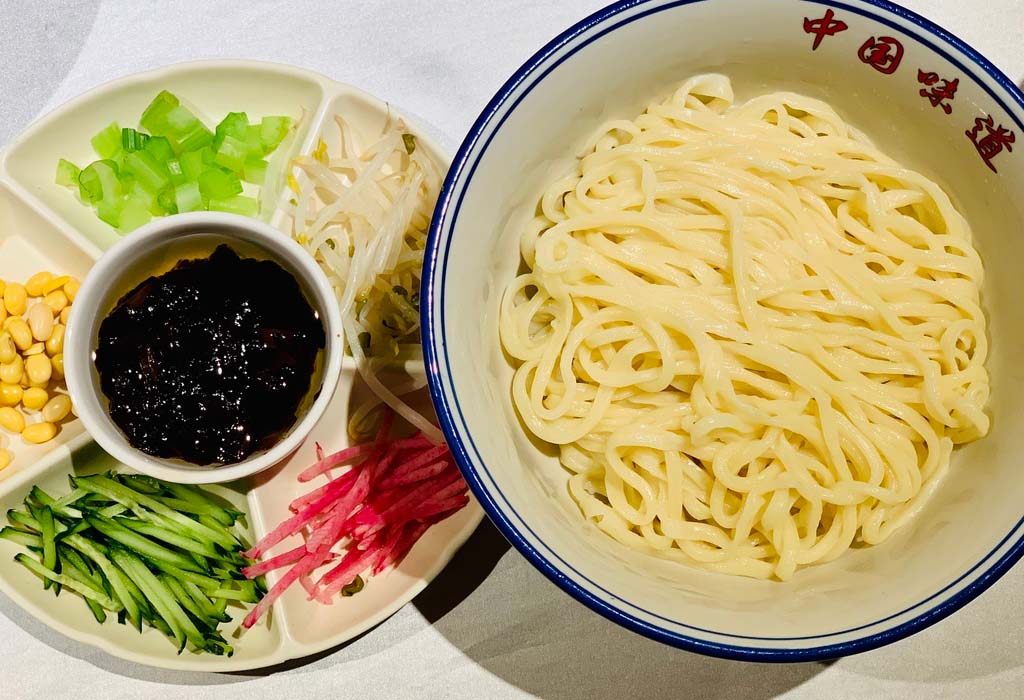
Taste Profile: Thick wheat noodles topped with savory fermented soybean paste sauce, diced pork, and fresh julienned vegetables like cucumber and radish.
Cultural Background: This “old Beijing” comfort food reflects the city’s working-class heritage. Zhajiangmian literally means “fried sauce noodles,” representing the hearty, economical meals that sustained Beijing residents through harsh northern winters. The dish embodies the principle of balancing rich, salty flavors with fresh, cooling vegetables.
Restaurant Recommendations:
- Hai Wan Ju (海碗居) – Traditional courtyard restaurant specializing in old Beijing cuisine, ¥35-50
- Yao’s Zhajiangmian (姚记炸酱面) – Local favorite with multiple branches, ¥20-30
- Donglaishun (东来顺) – Historic restaurant chain, also famous for hotpot, ¥40-60
Ordering Tips: Mix the noodles thoroughly with the sauce and vegetables before eating. Ask for “extra vegetables” (多加菜) if you prefer more fresh garnishes.
4. Mongolian Hot Pot (涮羊肉 / Shuàn Yángròu)
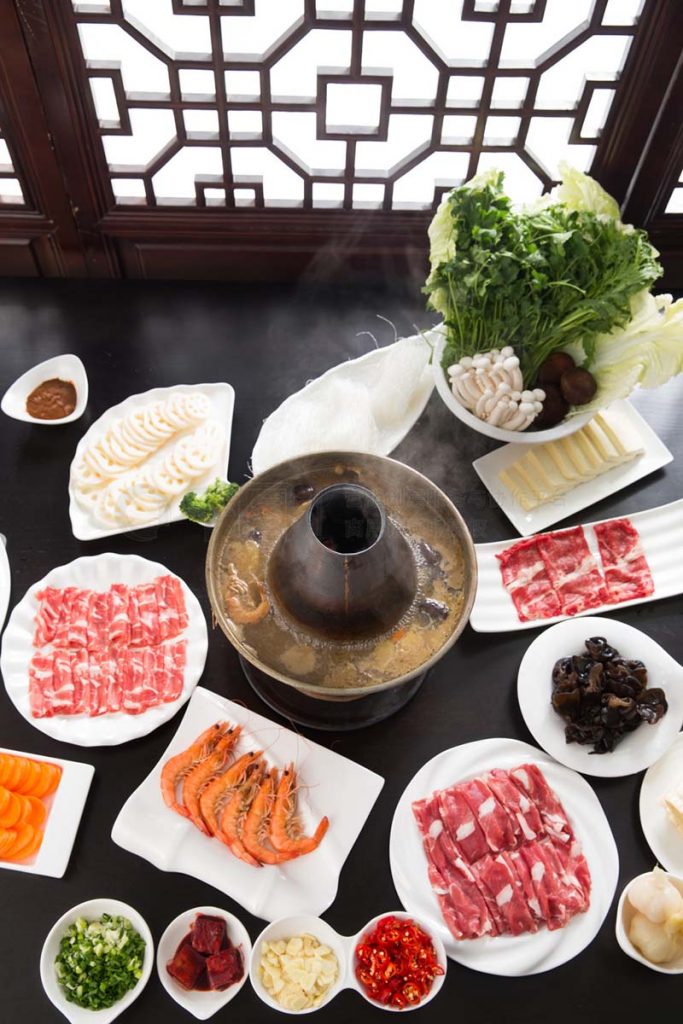
Taste Profile: Interactive dining experience featuring paper-thin lamb slices cooked in bubbling clear broth, accompanied by sesame-based dipping sauces and fresh vegetables.
Cultural Background: Reflecting Beijing’s proximity to Inner Mongolia, this hot pot style emphasizes the region’s pastoral traditions. Unlike Sichuan hot pot, Beijing-style uses mild, clear broths that allow the natural flavors of high-quality lamb to shine. The communal dining experience represents Chinese social bonding through food.
Restaurant Recommendations:
- Donglaishun (东来顺) – The most famous hot pot chain in Beijing since 1903, ¥80-120 per person
- Xiabu Xiabu (呷哺呷哺) – Modern chain with individual pot service, ¥60-90 per person
- Haidilao (海底捞) – Premium service with entertainment and hand-pulled noodles, ¥100-150 per person
Ordering Tips: Order lamb in advance as it’s sliced fresh. Dip cooked meat in sesame sauce (芝麻酱) mixed with cilantro and garlic. Cook vegetables and tofu after meat to absorb flavors.
5. Beijing-Style Shredded Pork with Bean Sauce (京酱肉丝 – Jīngjiàng Ròusī)
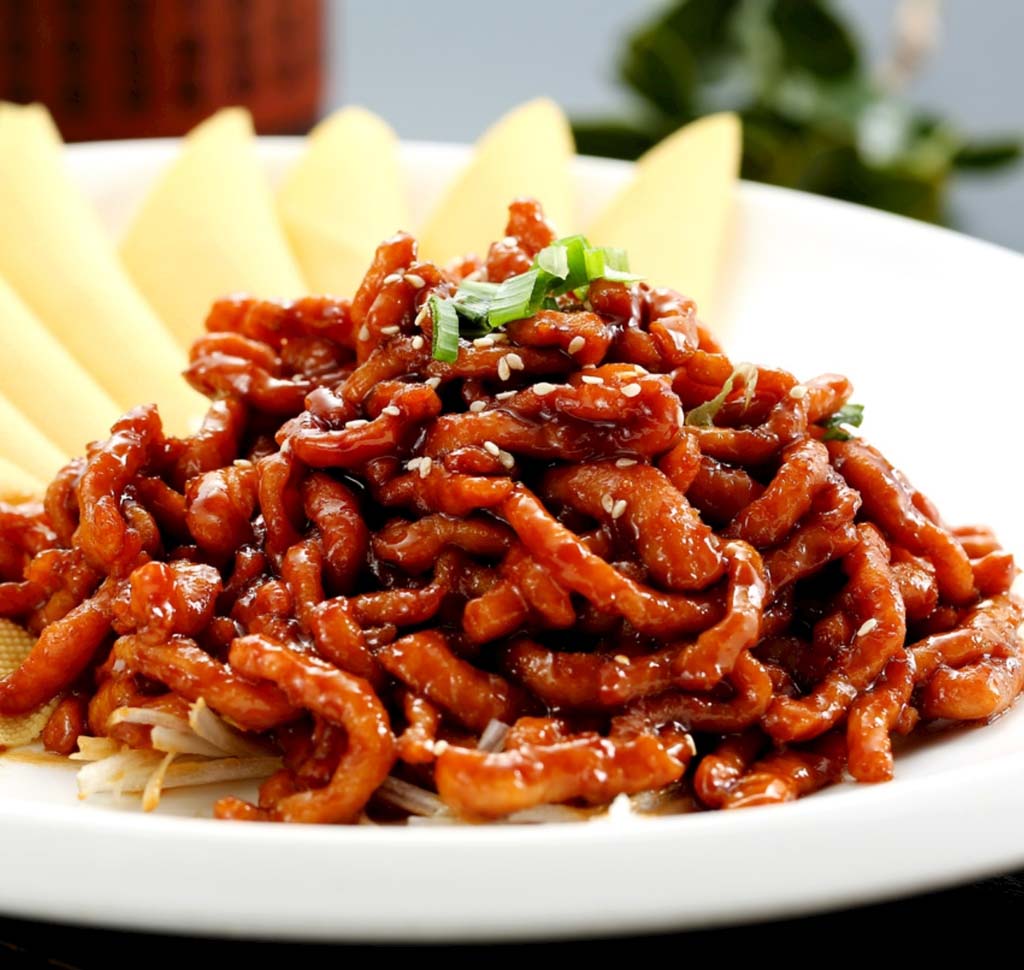
Taste Profile: Tender pork strips coated in sweet fermented bean sauce, paired with fresh scallions and cucumber, wrapped in thin pancakes for a perfect balance of savory-sweet flavors.
Cultural Background: This refined dish represents the evolution of Beijing’s imperial cuisine into home cooking. Jingjiang rousi demonstrates the Beijing culinary principle of “one sauce, multiple textures” – using the same fermented bean base as zhajiangmian but elevating it through precise knife work and presentation. The dish reflects the influence of Shandong cuisine on Beijing’s imperial kitchens, where chefs from eastern China brought their sophisticated techniques to the capital.
Restaurant Recommendations:
- Bianyifang (便宜坊) – Historic Peking duck restaurant also famous for refined Beijing dishes, ¥45-65 per dish
- Quanjude (全聚德) – Offers excellent versions alongside their famous duck, ¥38-58 per dish
- Local Shandong restaurants – Authentic preparation with traditional techniques, ¥25-40 per dish
Ordering Tips: Ask for extra pancakes (多要几张饼) as they’re essential for proper eating. The pork should be cut into matchstick-thin strips. Wrap like Peking duck – sauce, meat, vegetables, then roll in pancake.
Savory Delights & Hearty Snacks (Street & Shop Staples)
6. Baozi (包子 – Bāozi)
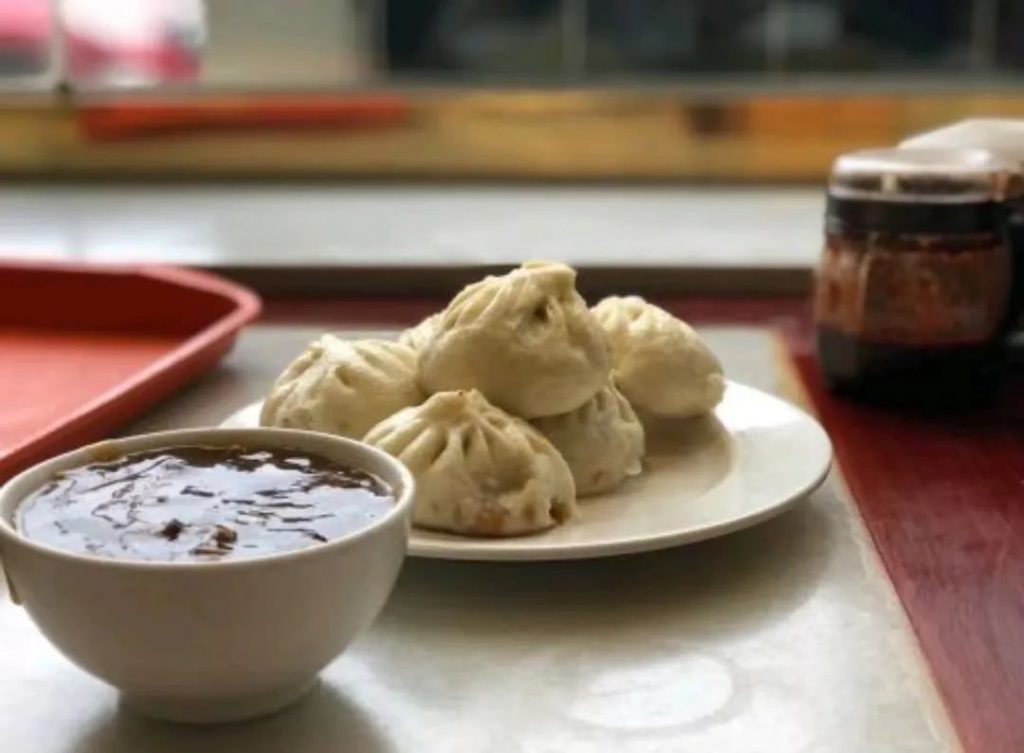
Taste Profile: Steamed bread buns with various fillings – pork and chive, vegetable, or sweet red bean – offering soft, pillowy texture with savory or sweet centers.
Cultural Background: These steamed buns represent one of China’s most fundamental foods, with origins tracing back over 1,800 years. In Beijing, baozi serves as both breakfast food and comfort snack, reflecting the northern Chinese preference for wheat-based staples over rice.
Restaurant Recommendations:
- Qingfeng Steamed Stuffed Bun Shop (庆丰包子铺) – Famous chain where Xi Jinping once dined, ¥3-8 per bun
- Goubuli (狗不理) – Tianjin-style baozi chain with Beijing locations, ¥15-25 per serving
- Local breakfast vendors – Street-side steamers offering authentic experience, ¥2-5 per bun
Ordering Tips: Eat immediately while hot. Be careful of hot soup inside pork buns – bite carefully to avoid burns. Vegetarian options include cabbage (白菜), mushroom (蘑菇), or sweet red bean (红豆) fillings.
7. Lamb Skewers (羊肉串 – Yángròuchuàn)
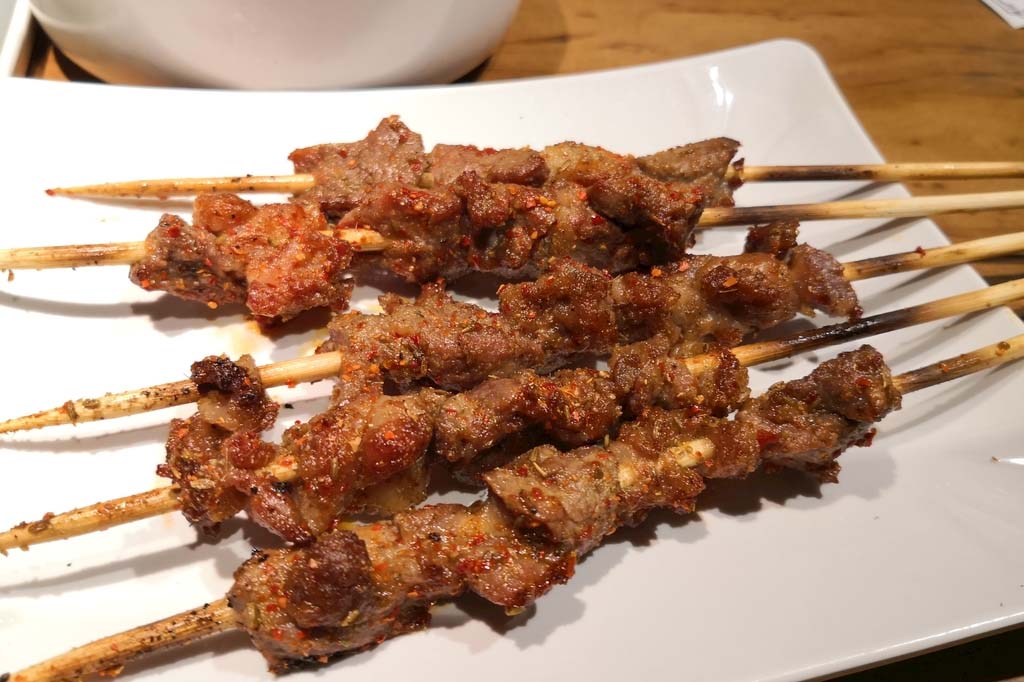
Taste Profile: Grilled cubes of marinated lamb with cumin, chili, and salt, delivering smoky, spicy flavors reminiscent of Central Asian barbecue.
Cultural Background: Reflecting Beijing’s multicultural influences from Xinjiang and Inner Mongolia, these skewers represent the city’s embrace of minority cuisines. The Uyghur grilling tradition has become integral to Beijing’s night market culture.
Restaurant Recommendations:
- Xinjiang restaurants in ethnic neighborhoods – Most authentic preparation, ¥5-8 per skewer
- Gui Jie (Ghost Street) – Famous food street with multiple vendors, ¥8-12 per skewer
- Night market stalls – Street-side grilling for authentic atmosphere, ¥6-10 per skewer
Ordering Tips: Order in groups of 5-10 skewers. Ask for spice level preference. Pair with cold beer or fresh yogurt to balance the heat and richness.
8. Beijing Yogurt (北京酸奶 – Běijīng Suānnǎi)
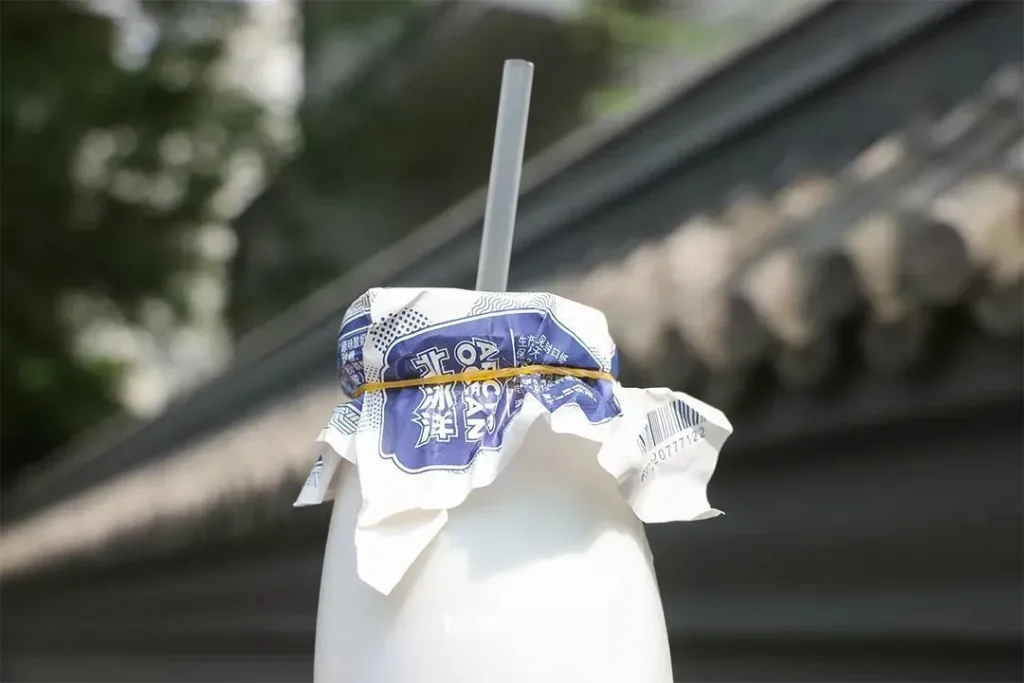
Taste Profile: Thick, tangy yogurt traditionally served in small glass or ceramic bottles, often slightly sweetened and refreshingly cool.
Cultural Background: This traditional dairy product reflects Beijing’s northern location and historical connections to Mongolia’s dairy culture. Unlike Western yogurt, Beijing-style is often less sweet and has a more pronounced tang.
Restaurant Recommendations:
- Traditional dairy shops – Small neighborhood vendors, ¥3-6 per bottle
- Supermarket brands – Modern packaging but traditional taste, ¥4-8 per bottle
- Restaurant dessert menus – Often served as palate cleanser, ¥8-15 per serving
Ordering Tips: Return glass bottles for deposit refund. Shake gently before drinking. Some vendors offer honey or sugar for additional sweetening.
9. Rolling Donkey (驴打滚 – Lǘ Dǎgǔn)
Taste Profile: Soft, chewy glutinous rice cake filled with sweet red bean paste and rolled in golden soybean flour, creating layers of texture from sticky to powdery with gentle sweetness.
Cultural Background: Despite its amusing name, this beloved Beijing dessert has nothing to do with donkeys. The name comes from the final step where the rice cake is rolled in soybean flour, resembling a donkey rolling in dust. Dating back to the Qing Dynasty, this treat represents Beijing’s sophisticated approach to street sweets, transforming simple ingredients into elegant desserts that were enjoyed by both commoners and nobility.
Restaurant Recommendations:
- Daoxiangcun (稻香村) – Famous Beijing pastry chain with traditional recipes, ¥8-15 per piece
- Traditional sweet shops in hutongs – Family-run businesses with homemade versions, ¥6-12 per piece
- Temple fair vendors – Seasonal availability during festivals, ¥10-18 per piece
Ordering Tips: Best eaten fresh and at room temperature. The soybean powder should be fine and aromatic. Ask about fillings – some versions use jujube paste instead of red bean.
10. Mung Bean Soup (绿豆汤 – Lǜdòu Tāng)
Taste Profile: Refreshing, mildly sweet soup with tender mung beans, served chilled during summer months, providing cooling relief with subtle, clean flavors.
Cultural Background: This humble soup embodies Traditional Chinese Medicine principles, specifically the concept of “cooling foods” for hot weather. Mung bean soup has sustained Beijing residents through scorching summers for over 1,000 years, representing practical nutrition wisdom passed down through generations. In Beijing culture, offering mung bean soup to guests during summer demonstrates hospitality and care for their wellbeing.
Restaurant Recommendations:
- Traditional tea houses – Served as complimentary refreshment, ¥5-10 per bowl
- Street vendors with cooling drinks – Fresh preparation throughout the day, ¥3-8 per cup
- Beijing-style restaurants – Often provided as palate cleanser, ¥8-15 per bowl
Ordering Tips: Best enjoyed ice-cold during summer months (June-August). Some vendors add rock sugar – specify your sweetness preference. Look for vendors who cook beans until they split open for optimal texture.
11. White Fungus Soup (银耳羹 – Yín’ěr Gēng)
Taste Profile: Silky, gelatinous soup with delicate white fungus, often sweetened with rock sugar and enhanced with lotus seeds or red dates, offering subtle earthiness and natural sweetness.
Cultural Background: This nourishing dessert soup represents Beijing’s sophisticated understanding of functional foods. White fungus (snow fungus) has been prized in Chinese cuisine for over 2,000 years, originally reserved for imperial concubines due to its supposed beauty-enhancing properties. The soup embodies the Chinese philosophy of food as medicine, providing collagen and nutrients while serving as an elegant ending to meals.
Restaurant Recommendations:
- Upscale Beijing restaurants – Refined preparation with premium ingredients, ¥25-45 per bowl
- Traditional Cantonese restaurants – Expert double-boiling techniques, ¥20-35 per bowl
- Dessert specialists – Focused preparation with various additions, ¥15-28 per bowl
Ordering Tips: Order as dessert rather than main course. The fungus should be translucent and tender, not rubbery. Common additions include goji berries (枸杞), lotus seeds (莲子), or red dates (红枣).
12. Old Beijing Stuffed Pancake (老北京馅儿饼 – Lǎo Běijīng Xiàn’r Bǐng)
Taste Profile: Crispy, golden pancake stuffed with savory fillings like seasoned pork and cabbage, offering contrasting textures of crunchy exterior and juicy, flavorful interior.
Cultural Background: This working-class comfort food represents Beijing’s practical approach to satisfying meals. Xianer bing emerged during the Ming Dynasty as an economical way to stretch meat with vegetables and grain, creating filling meals for laborers and craftsmen. The dish reflects Beijing’s northern Chinese heritage, where wheat-based foods dominate and hearty, warming meals are essential for cold winters.
Restaurant Recommendations:
- Street-side pancake vendors – Most authentic preparation, ¥8-15 per pancake
- Traditional Beijing breakfast shops – Family recipes passed down generations, ¥12-20 per pancake
- Night market stalls – Freshly made with various filling options, ¥10-18 per pancake
Ordering Tips: Specify filling preference – pork and cabbage (猪肉白菜) is most traditional. The pancake should be eaten hot and crispy. Watch the cooking process – authentic versions are pan-fried until golden brown.
13. Candied Hawthorn on Sticks (糖葫芦 – Tánghúlu)
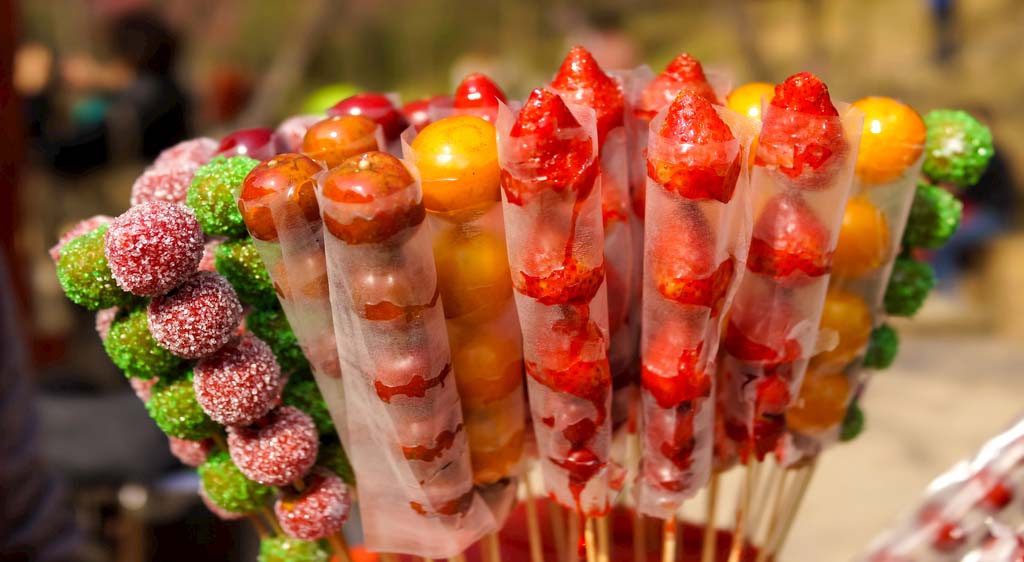
Taste Profile: Bright red hawthorn berries encased in crispy, translucent sugar coating, delivering intense sweet-tart flavor that cleanses the palate and provides vitamin C.
Cultural Background: This iconic Beijing street snack carries over 800 years of history, originally created during the Song Dynasty as both treat and medicine. Hawthorn berries aid digestion according to Traditional Chinese Medicine, making tanghulu the perfect end to heavy meals. The bright red color symbolizes good fortune in Chinese culture, making these treats especially popular during Chinese New Year and festivals. For many Beijing children, tanghulu represents their first taste of independence – buying treats with pocket money from street vendors.
Restaurant Recommendations:
- Wangfujing Snack Street – Tourist area with creative variations, ¥10-25 per stick
- Traditional temple fairs – Seasonal vendors during festivals, ¥8-18 per stick
- Hutong street vendors – Most authentic preparation by elderly vendors, ¥5-15 per stick
Ordering Tips: Choose sticks with plump, unblemished berries. The sugar coating should crack audibly when bitten. Modern versions may include strawberries, grapes, or other fruits, but traditional hawthorn offers the most authentic experience. Eat quickly as humidity softens the sugar coating.
The Adventurer’s Lane (Embrace the Unexpected!)
14. Fried Liver (炒肝 – Chǎogān)
Taste Profile: Thick, starchy soup made from pig liver and intestines with garlic and star anise, creating rich, dense texture and distinctive organ meat flavors.
Cultural Background: This challenging breakfast dish represents authentic Beijing working-class cuisine. Fried liver (despite its name, it’s actually stewed) sustained laborers with protein-rich, filling nutrition during harsh northern winters.
Restaurant Recommendations:
- Tianxingju (天兴居) – Historic restaurant specializing in traditional breakfast, ¥15-25 per bowl
- Yaoji Chaogan (姚记炒肝) – Famous specialist chain, ¥18-28 per bowl
- Traditional breakfast vendors – Most authentic but challenging for foreigners, ¥12-20 per bowl
Ordering Tips: This is advanced-level Beijing cuisine – consider your tolerance for organ meats. Traditionally eaten without utensils, sipping directly from bowl. Pair with baozi to balance the richness.
15. Douzhi (豆汁 – Dòuzhī)
Taste Profile: Fermented mung bean drink with a distinctively sour, slightly funky taste that locals describe as an “acquired taste” – often served with pickled vegetables.
Cultural Background: This polarizing beverage represents “real Beijing” culture more than any other food. Douzhi has sustained Beijing residents for over 1,000 years, originally consumed by the poor but eventually embraced by all social classes. It’s considered the ultimate test of whether you truly understand Beijing cuisine.
Restaurant Recommendations:
- Jinxin Douzhi Shop (锦馨豆汁店) – Specialist shop in traditional hutong area, ¥8-12 per bowl
- Yaoji Chaogan (姚记炒肝) – Famous for breakfast combinations, ¥6-10 per bowl
- Traditional breakfast stalls – Most authentic but challenging for foreigners, ¥5-8 per bowl
Ordering Tips: Start with small portions – this drink divides even Chinese people. Pair with pickled vegetables (咸菜) to balance the sour flavor. Don’t feel obligated to finish if you don’t enjoy it.
Conclusion: Your Beijing Culinary Adventure Awaits
Beijing’s food scene offers Western travelers far more than typical tourist restaurant experiences. These 15 dishes represent centuries of culinary evolution, from imperial kitchens to street-side vendors, creating a edible history lesson that challenges preconceptions about Chinese cuisine.
Start with familiar flavors like Peking duck and xiaolongbao, then gradually explore more adventurous options like douzhi or fried liver. Remember that food safety in Beijing is generally excellent, especially in established restaurants and popular food districts.
Each dish tells a story about Beijing’s cultural heritage, seasonal wisdom, and social traditions. Whether you’re sharing hot pot with new friends or braving stinky tofu as a personal challenge, Beijing’s cuisine offers unforgettable cultural discoveries that extend far beyond simple sustenance.
Your Beijing food adventure awaits – embrace the unexpected, trust local recommendations, and prepare for flavors that will forever change your understanding of Chinese cuisine.

